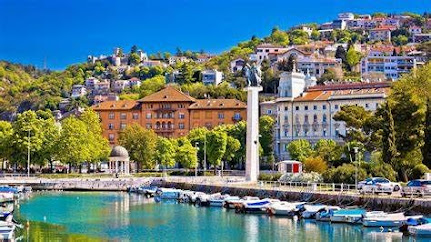“The river is everywhere at once, at the source and at the mouth, at the waterfall, at the ferry, at the rapids, in the sea, in the mountains, everywhere.”
~Herman Hesse, Siddhartha=======================================================================
(in Bavaria, Germany, close to the Austrian border) The power of flowing water has quite literally shaped the picturesque town of Passau. Known as Dreiflüssestadt (City of Three Rivers), Passau is the place where the Danube meets the Inn and the Ilz. The picturesque city lies in Germany’s far southeast corner. Settled since prehistory and a former hub of the salt trade, it became the Roman village of Batavis, then later the Holy Roman Empire’s largest diocese and a sword-making center. Saint Stephan’s Cathedral, home of the world’s second-largest cathedral organ, is one of Passau’s favorite attractions. Many river cruises down the Danube start at Passau and there is a cycling path all the way down to Vienna. (It is on the designated heritage route, the Route of Emperors and Kings.)
+ Passau is notable for its gothic and baroque architecture. The city is dominated by the Veste Oberhaus and the Veste Niederhaus, both parts of the former fortress of the Bishop, on the mountain crest between the Danube and the Ilz. Tourism in Passau focuses mainly on the three rivers, the St. Stephen's Cathedral (German: Der Passauer Stephansdom) and the "Old City" (Die Altstadt).
+ Before the cathedral is a large square (Domplatz) with the Lamberg-Palais, where the Peace of Passau was concluded. The medieval Old Residence south of the cathedral and the baroque New Residence further west at Residenzplatz were the palaces of the Prince-Bishops within the city. Right beside the 14th century Gothic City Hall with its neo-Gothic tower and the big 19th-century former Hauptzollamtsgebäude (Main Customs Office) at the Danube is the Scharfrichterhaus -- an important jazz and cabaret stage on which political cabaret is performed.
+ Passau has become the economic, cultural, and communications center of southeastern Bavaria. Industries include a bell foundry, brewing, and the manufacture of clothing, bicycles, organs, and electrical engineering products. There is also a tourist trade based in part on the city’s role in passenger boat traffic on the Danube. The cityscape is dominated by the Oberhaus Fortress and the cathedral of St. Stephen, which incorporates the remains of an earlier Gothic structure. The cathedral contains one of the largest church organs in the world; this organ, built in 1928, has more than 17,000 pipes. The bishops’ palace and numerous fine churches in varied styles recall the era of the prince-bishops. The Gothic Town Hall has paintings depicting episodes in Passau’s past, including its association with the Nibelungen legends. The Niedernburg convent contains the tomb of Gisela, the first queen of Hungary. The city is the seat of the University of Passau Museums include the Oberhaus Museum, the Passau Glass Museum , a museum of modern art, and a diocesan museum.













,%20in%20the%20city%20of%20Cologne,%20Germany.jpg)










